Environment
Marking the Environment Day on June 5, NepalMinute surveyed official reports and databases for a lead on the status of biodiversity around us, beginning with birds in need of protection from threats to their survival as species.
The National Red List of Nepal's Birds, published by the Zoological Society of London in 2017, had assessed the conservation status, trends and threats pertaining to 875 bird species recorded in Nepal then, some 8 per cent of the world’s known bird species.
The Department of National Parks and Wildlife Conservation (DNPWC) featured Himalayan Monal, Sarus Crane, Cheer Pheasant, Satyr Tragopan, Bengal Florican, Lesser Florican, Great Hornbill, Black Stork and White Stork as birds needing protection.
Laws under CITES and Nepal’s National Parks and Wildlife Conservation Act 1973 gave these birds a protected status, calling for their conservation.
The call rang louder as bird species were being lost. Mountain Quail of the western Himalayas, for example, was reported extinct.
“Nine species have not been recorded in Nepal since the 19th century,” the Red List noted. “Nearly 20% of Nepal’s birds (167 species) are threatened with extinction, Satyr Tragopan being one of them.”
To assess the level of threat to all species, not just birds, the IUCN (International Union for the Conservation of Nature) had developed the master Red List accounting for the size, trend and range of their population, attaching labels such as Extinct (EX), Extinct in the Wild (EW), Critically Endangered (CR), Endangered (EN), Vulnerable (VU), Near Threatened (NT), Least Concern (LC) and Data Deficient (DD) to highlight their predicaments.
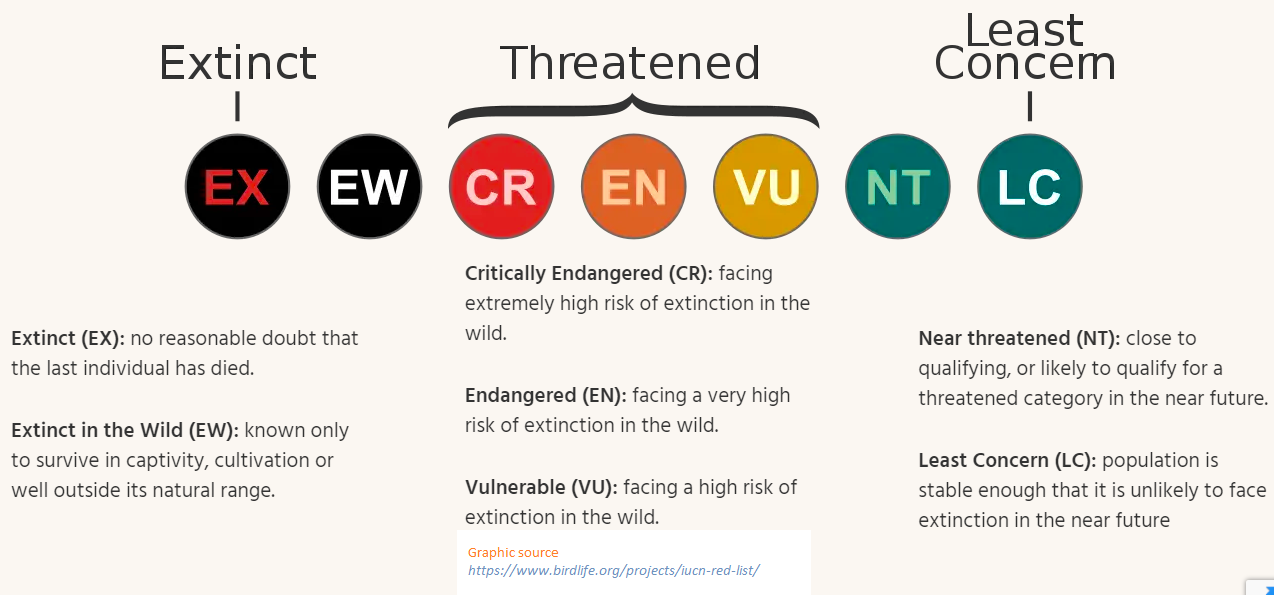
BirdLife International used the Red List to assess the status of birds, over 11,000 species worldwide.
Its 2022 update on the State of the World’s Birds said the birds were faring worse than before, signalling wider environmental problems and erosion of biodiversity. Sharp declines in formerly common and widespread birds were particularly alarming, it added.
“Since the year 1500, we have lost over 150 bird species – an extinction rate far higher than the natural background. Today, one in eight bird species is threatened with global extinction, with 222 species Critically Endangered,” the report said.
Its Bird and Biodiversity Targets Report (2020) sounded positive about the ongoing conservation efforts, despite the threats.
“What do the birds show us?” BirdLife International wrote in a tweet about its 2020 report. “Conservation efforts can make a real change! Up to 18 #bird species have been prevented from going extinct since 2010 and the effective extinction rate has been slowed by at least 40%.”
Poaching, forest degradation and habitat encroachment were among main threats to birds globally, as they were in Nepal.
With stunning topographical variations from the sea level to 8848m in altitude, within less than 200km, Nepal provided a unique home to the bird species, at least a few, such as Spiny Babbler, that is, Kaande Vyakur in Nepali, with its scientific name Acanthoptila nipalensis, being endemic to the country.
Annapurna Conservation Area, Dharan forests, Kanchenjungha Conservation Area, Langtang National Park, Mai Valley forests, Makalu Barun National Park, Phulchoki Mountain forests, Shivapuri-Nagarjun National Park and Tamur Valley Watershed were important bird sanctuaries of the central Himalayas. Arun-Kosi Valley in the east and Kali Gandaki Valley in the west flanked the bird areas, making Nepal a compelling case for conservation efforts along the Himalayan ranges.
As Nepal’s conservation success story, official documents credited Nepal government and Bird Conservation Nepal (BCN, BirdLife in Nepal) with bringing vultures from the brink of extinction through feeding schemes, or vulture restaurants, among others. Vultures exposed to diclofenac, a drug used to treat livestock, were imperilled in Nepal and its neighbourhood over the last two decades, according to the BCN.
What about their prettier counterparts? NepalMinute looked into the status of the protected birds on the list of DNPWC, with their pictures for a peek and some details about them that follow.
Himalayan Monal or Danfe
Danfe, a resident of the Himalayas, is the national bird of Nepal. It lives in alpine and sub-alpine heights, up to 4750m, on steep grassy and rocky slopes or adjacent forests in summer, and descends to rhododendron forests, 3300m, in winter, at times of heavy snowfall.
The main threats to the bird arise from local hunters during winter, when it comes down, closer to human settlements. Shepherds and poachers trap and kill the bird for meat and its beautiful plumage.
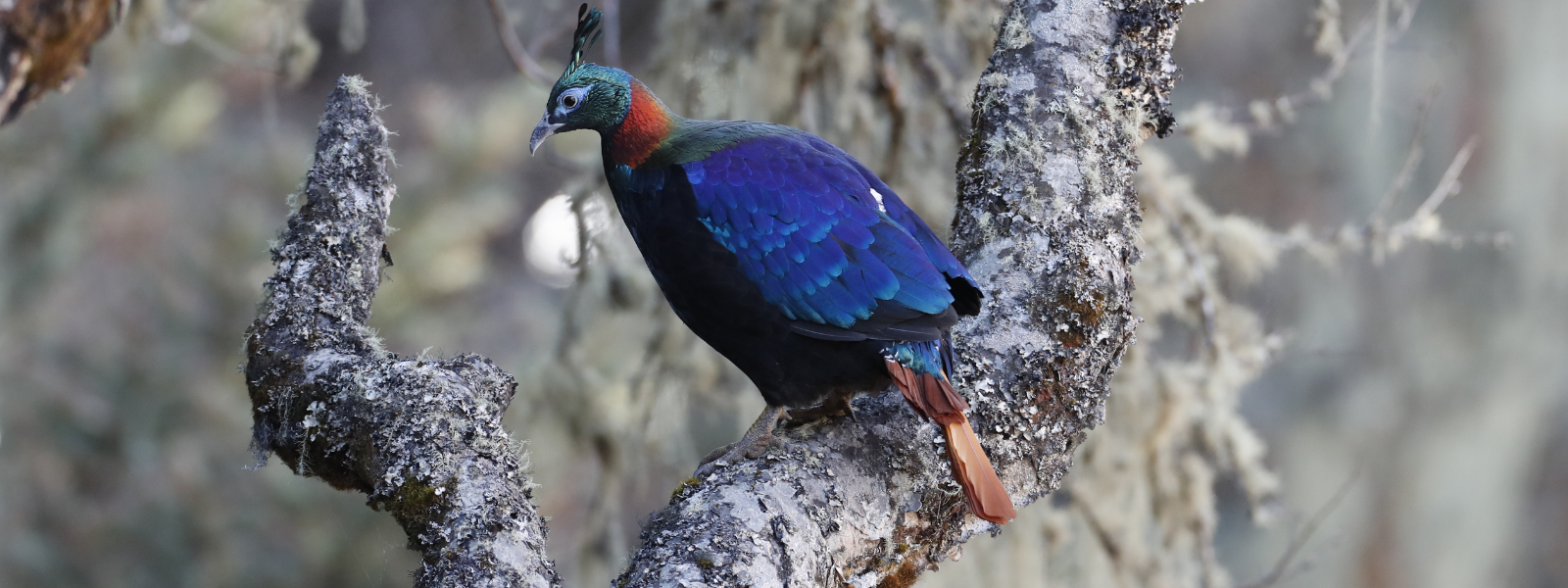
Himalayan Monal, the national bird of Nepal, at risk of being killed for its beautiful plumage. (Photo source: birdlifenepal.org)
Danfe is fairly common and widespread in Makalu Barun, Sagarmatha, Langtang, Shey Phoksundo, Khaptad and Rara National Parks; Dhorpatan Hunting Reserve; Kanchenjungha, Gaurishankar, Manaslu, Annapurna and Api Nampa Conservation Areas.
The population of Danfe in Nepal is estimated between 3500 and 5000 individuals. Its global population is unknown.
Danfe males have a long crest and colourful feathers. Females are dull in colour, with their upper parts covered with dark brownish-black feathers. Females have a prominent white patch in the fore neck and a white strip on the tail.
Polygamous, perhaps, males go with more than one female. The bird is usually quite shy and flushes at a considerable distance. Flushed, the birds take to wing, emitting a loud call sounding like pi-pi-pi.
It digs with powerful bill, under trees and open lands, for insects and tubers, to eat besides grass roots and seeds, berries and mosses. It lays eggs in rudimentary nests on ground during May-June, under boulders, bushes or holes on the tree trunks. Incubation period is generally 28 days.
Himalayan Monal is about 70cm in length and weighs on average about two kilos. It is native to Nepal, India, Pakistan, Bhutan, China and Myanmar.
Conservation details here.
Sarus Crane or Saras
Saras is a very large crane, averaging 156cm in length, weighing a maximum average of 7.3kg. In Nepal, it is an uncommon and local resident of Lumbini and Western Tarai, living in freshwater marshes and plains.
It is known to breed regularly in farmlands of Rupandehi and Kapilbastu. Beldandi and Kalikich wetlands of Shuklaphanta Wildlife Reserve, Badhaiya Tal of Bardia, Nepalgunj in Banke district, Dang district, Jagdishpur Reservoir – a ramsar site and Nawalparasi-Chitwan districts of Chitwan National Park and Buffer Zone have reported its presence. The estimated population of Sarus Crane in Nepal is over 700 individuals.
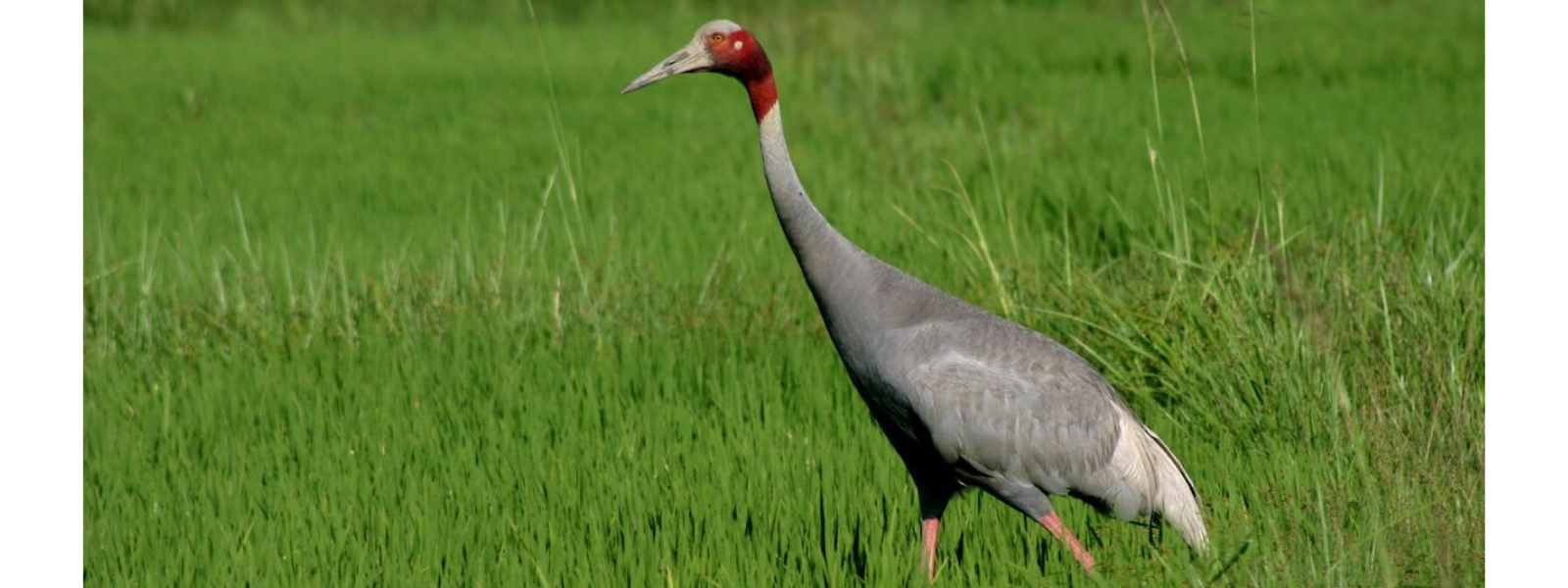
Saras, a very large crane, averaging 156cm in length. (Photo source: birdlifenepal.org)
Adults of both sexes are grey with a bare red head and white crown and a long dark pointed bill. In flight, the long neck is straight and the black wing tips can be seen; their long red or pink legs trailing behind.
The bird, Grus antigone by its scientific name, is native to Nepal, Australia, Cambodia, China, India, Lao People's Democratic Republic, Myanmar, Pakistan, and Vietnam. It is also found in Bangladesh.
Records show Indian male Sarus Cranes are up to 200cm tall, with a wingspan of 250cm, making them the world's tallest living flying bird. The species has been extinct from Malaysia, Thailand and Phillipines.
Conservation details here.
Cheer Pheasant or Cheer Kalij
Cheer Pheasant is a local resident of the highlands and scrublands of western Nepal (1445-3050m altitude), such as Annapurna Conservation Area of the Himalayas, and frequents to Dhorpatan Hunting Reserve.
The bird lacks the colour and brilliance of most pheasants, with gray plumage and long gray crests. It lives for up to 6 years.
Lower Kali Gandaki valley of Annapurna Conservation Area; Rara National Park; Kaphalpani, Dhaukudi, Kasanidada and Kulau VDC of Baitadi District; Tisimi dada and Kanachaur VDC of Doti District; Jumla Bazaar and Dhapa VDC of Jumla district; Dhanaikot VDC of Mugu district; Basti, Balata, Kuntibandali and Bhairabsthan VDC of Achham District; Dolpa district; Yalbang area in Humla district; and Kshetti area of Api Nampa Conservation Area have reported the presence of Cheer Pheasant.
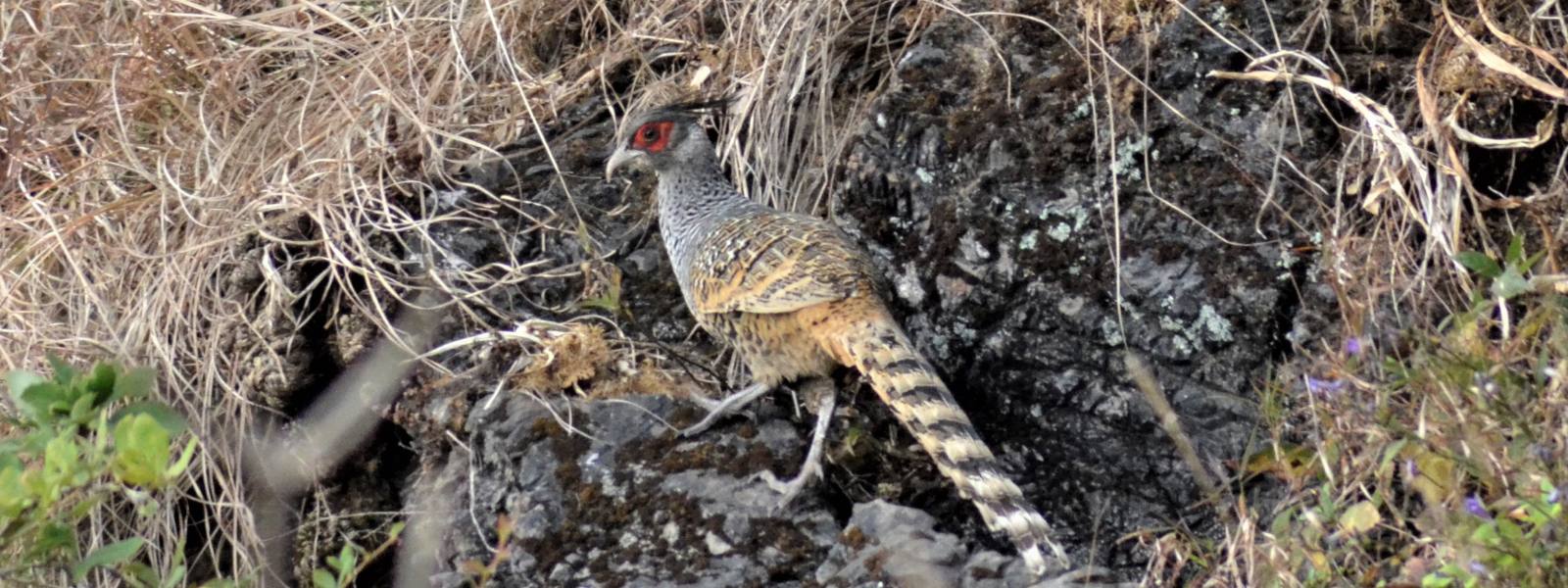
Cheer Pheasant, a local resident of Nepal’s western highlands and scrublands. (Photo source: birdlifenepal.org)
The population of Cheer Pheasant, scientific name Catreus wallichii, is estimated at a maximum of 1000 in Nepal. Its global population is around 3000-4,000 individuals. The bird is native to Nepal, India and Pakistan. Globally threatened, captive-bred Cheer Pheasants are being reintroduced in Pakistan.
Conservation details here.
Satyr Tragopan or Munal
Munal is a scarce resident of the Himalayas, found in moist oak and rhododendron forests with dense undergrowth and bamboo clumps, mixed forest, scrub and densely vegetated ravines in gentle and steep slopes.
Satyr is partly arboreal; nests have been found in trees and also on the ground.
Males have red under parts with black-bordered white spots and olive brown coloration on upperparts. Their face is blue. Female is rufous-brown with white streaking and spotting. It lives in a solitary space or in pairs.
Reports of its presence at heights of 2500-3800m in summer and 2100m in winter have been received from Khaptad, Shey Phoksundo, Langtang, Sagarmatha and Makalu Barun National Parks, Dhorpatan Hunting Reserve, and Api Nampa, Annapurna, Manaslu, Gaurishankar and Kanchenjungha Conservation Areas.
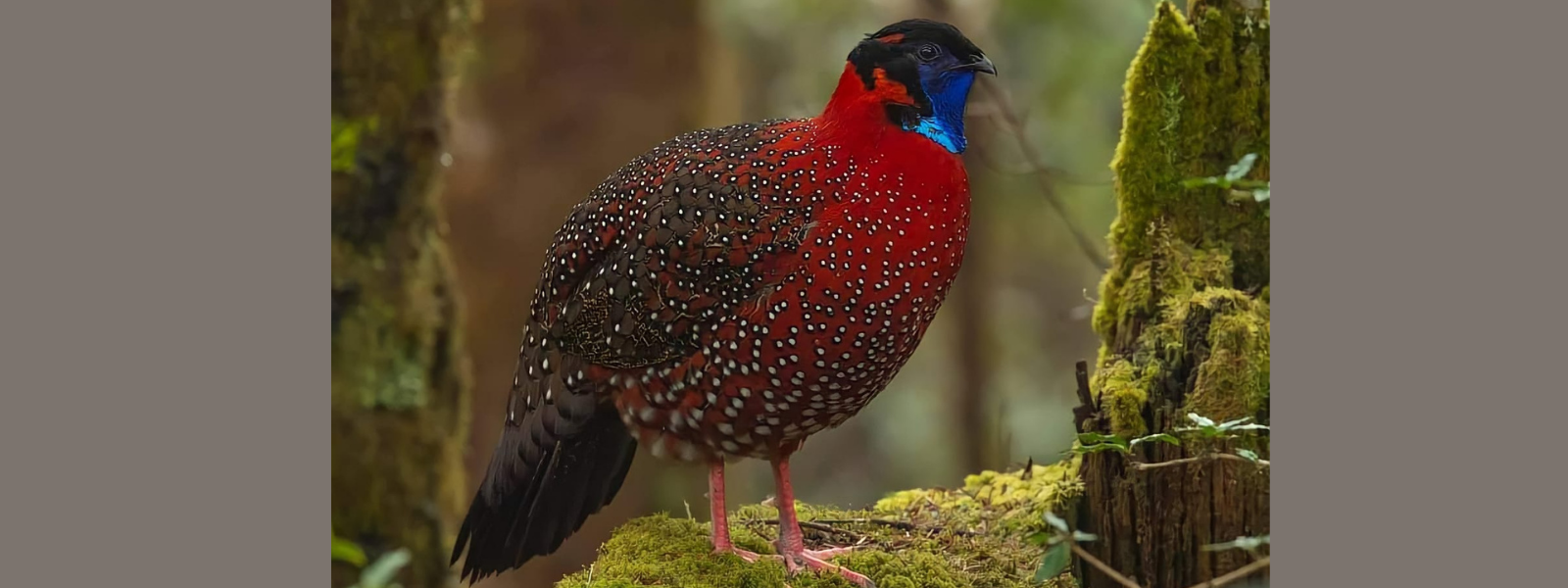
Satyr Tragopan, a scarce resident, likes to roam in rhododendron forests and bamboo clumps. (Photo by David Thinley Wangchuck, Bhutan, Source:birdlifenepal.org)
Major threats to this bird include hunting for local consumption as well as habitat clearance and degradation due to timber harvesting, fuelwood and fodder collection and livestock grazing. Extraction of bamboo also poses problems for habitat of the species, given its association with bamboo undergrowth.
Its population in Nepal is estimated between 600 and 1000 individuals. The world population is below 20,000 individuals.
The birds feed on young leaves and other edible parts of plants like Berberis and Rhododendron, in addition to mosses, grasses and insects, lichens and quartz fragments.
Conservation details here.
Bengal Florican or Kharmujur
The Bengal Florican is a large terrestrial omnivorous bird.
It is a highly threatened and rare bird species that nests on the ground, inhabiting in Nepal, India, Cambodia and Vietnam with a world population of only 250-999. It has two sub species: Houbaropsis bengalensis bengalensis which exists in India and Nepal and Houbaropsis bengalensis blandini which subsists in Cambodia and Vietnam.
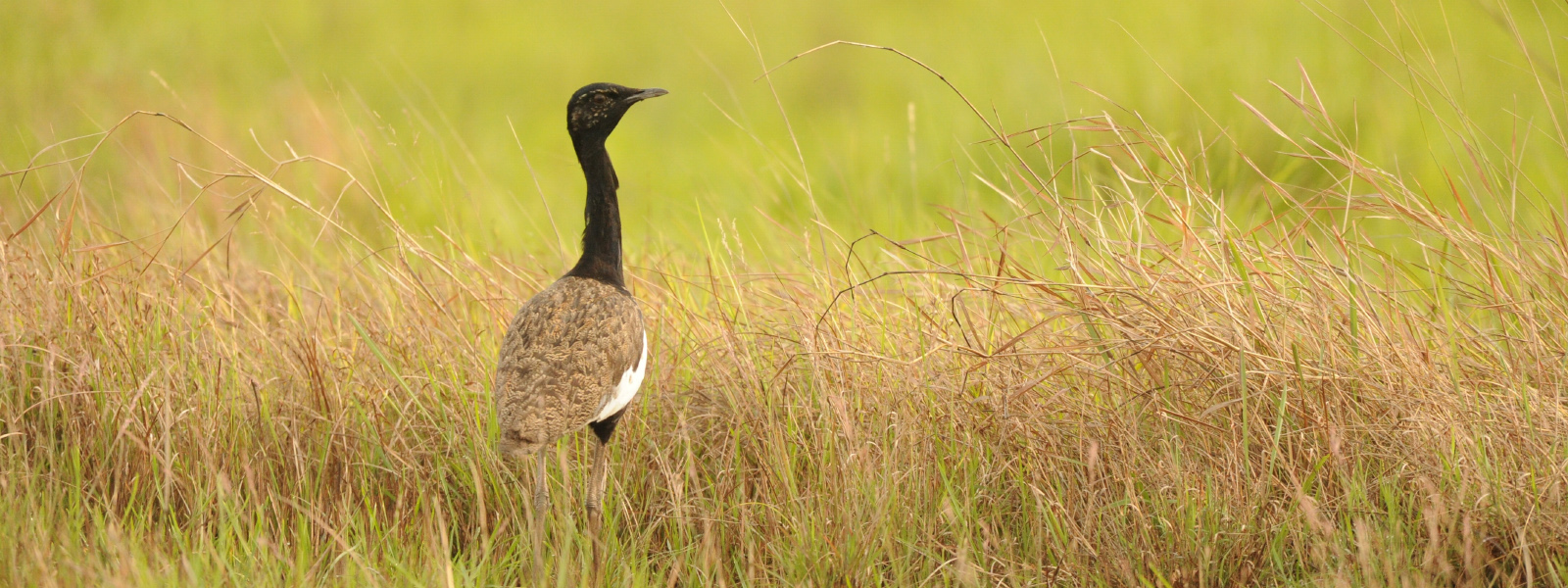
Bengal Florican, a rare bird species that nests on the ground. (Photo by Jonathan Eames, Source: birdlifenepal.org)
In Nepal its population is estimated between 65 and 100 individuals. This bird is found in alluvial grasslands in Chitwan National Park, Bardia National Park, Suklaphanta Wildlife Reserve, Koshi Tappu Wildlife Reserve and Koshi Barrage area. Its population is small and rapidly declining due to widespread loss of grassland habitat in its range. It is usually poached for its feathers.
The male has black colour going from head to neck and underparts. It has a conspicuous white patch on the wing converts. Females are larger than males and have a buff brown colour, with a dark brown crown and narrow dark streak down the side of the neck.
It was uplisted from Endangered to Critically Endangered status in the 2007 IUCN Red List.
Conservation details here.
Lesser Florican or Sano Kharmujur
Lesser Florican is a rare summer visitor in Nepal, a small, slim, long-necked bustard, with less white on the wing than Bengal Florican.
It is found in dry grassland and crops. It was recorded in Kathmandu valley in the 19th Century.
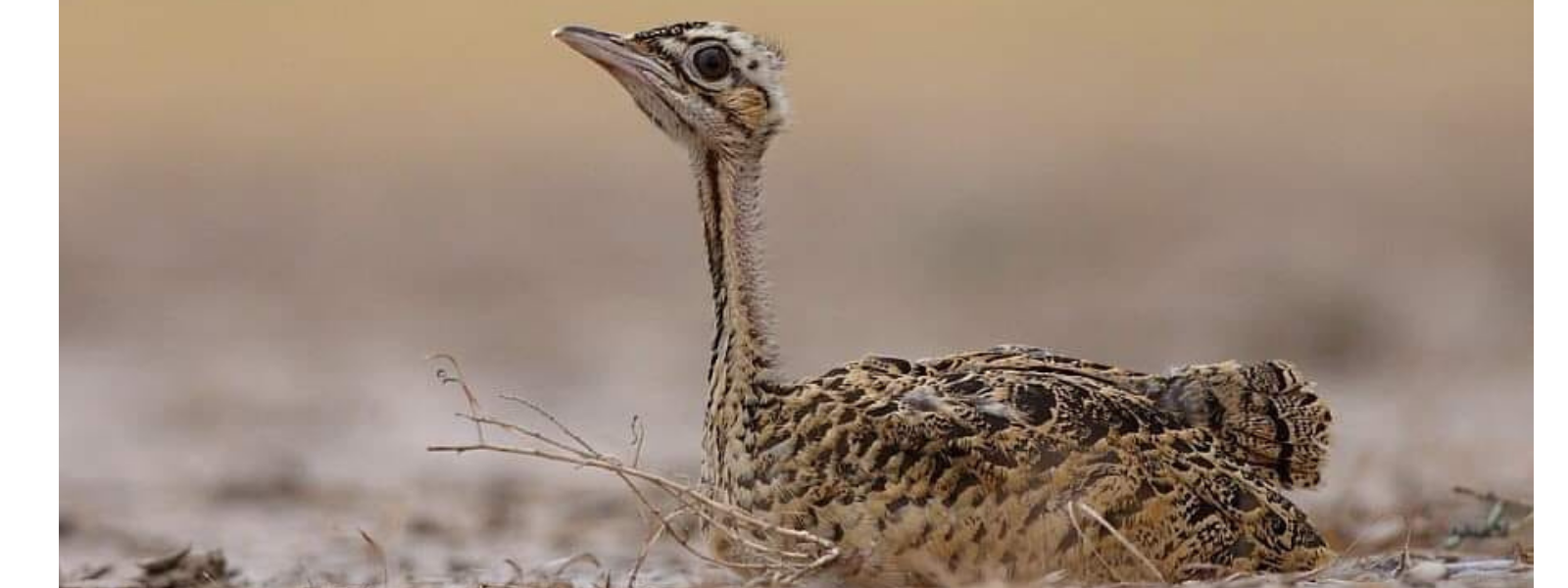
Lesser Florican, a rare summer visitor in Nepal. (Photo Credit: Nirav Bhatt, internet, birdlifenepal.org)
Presently, a very few sightings of the species have been reported, such as from Koshi Tappu Wildlife Reserve and Chitwan and Bardia National Parks. The estimated maximum population of the bird is 10 individuals in Nepal.
The bird, scientific name Sypheotides indicus, is also native to India and Pakistan.
Conservation details here.
Great Hornbill or Rajdhanesh
Great Hornbill is a rare and local resident of the Himalayas.
It is a large bird with a very large bill. The body is mostly black with a white neck, wing coverts and flight feathers. Its size is 100-120cm, with a 150cm wingspan.
Chitwan National Park and its buffers: Barandbahar forests, Kumroj and Namuna Community Forests; Bardia National Park, Parsa Wildlife Reserve, Ghodaghodi lake area, Kapilbastu District forests, Sarlahi District forests, between Garuwa and Sukhani of Jhapa/Ilam Districts, Ram Dhuni Sal forest of Sunsari district and Raja Rani Community Forest of Morang District have reported the bird.
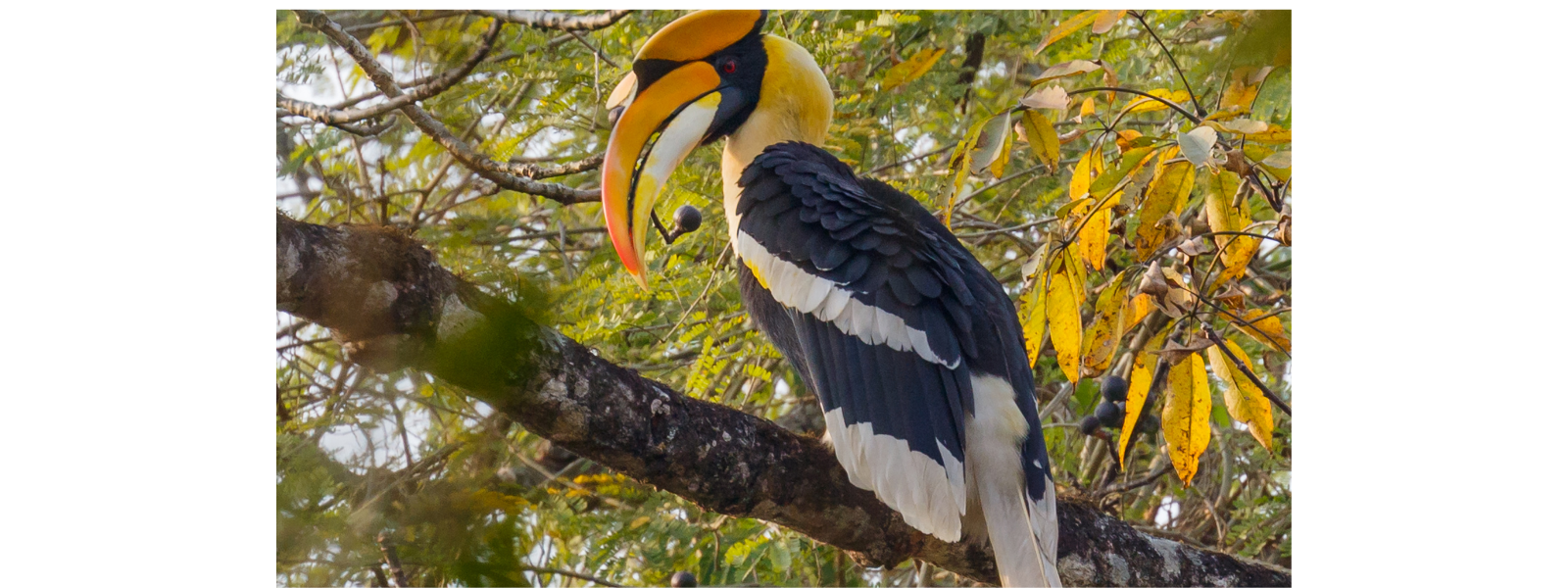
Great Hornbill or Rajdhanesh, a large bird with a very large bill. (Photo source: birdlifenepal.org)
The estimated population of Great Hornbill in Nepal is between 80 and 150 individuals.
The bird, scientific name Buceros bicornis, is native to Nepal, Bhutan, Cambodia, China, India, Indonesia, Lao People's Democratic Republic, Malaysia, Myanmar, Thailand and Vietnam.
Conservation details here.
Black Stork or Kalo Garud
Black Stork is a winter visitor in Nepal, found below 1000m, and a passage migrant to 2925m in altitude. Since 1990 it has been recorded in Chitwan and Bardia National Parks and Sukla Phanta, Parsa and Koshi Tappu Wildlife Reserves. The maximum estimated population of Black Stork in Nepal is 1000 individuals.
Outside the protected areas, it has been recorded from Dang Deukhuri Important Bird Area, Pokhara and Begnas Tal of Kaski District, Gaidakot of Nawalparasi district, Dharan Forests Important Bird Area, with uncommon sightings at Dhorpatan Hunting Reserve at the altitude of 2925m in 1981 and 1998 and passage migrant in Makalu Barun National Park in 1995-1996.
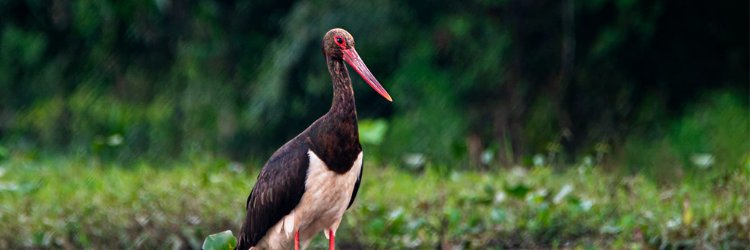
Black Stork, or Kalo Garud, a large bird, nearly 1m tall and weighing around 3kg. (Photo source: birdlifenepal.org)
This is a large bird, nearly 1m tall with a 1.8m wingspan, weighing around 3kg. It is all black except for the white belly and pit, and its red bill and legs. It walks slowly and steadily on the ground. Like all storks, it flies with its neck outstretched.
Black Stork feeds mainly on fish and also amphibians and insects. This is a shy and wary species, unlike the closely related White Stork.
It breeds in large marshy wetlands with interspersed coniferous or broad lived woodlands, but also inhabits hills and mountains with sufficient network of creeks. It builds a stick nest high in trees.
Globally the species has been recorded from Nepal, Bhutan, China, India, Myanmar, Pakistan, Europe, Africa, Central Asia, Middle East, South-East Asia and East Asia. Its global population is estimated to number 24,000-44,000 individuals.
Conservation details here.
White Stork or Seto Garud
White Stork is a long-distance migrant, wintering sometimes in South Asia and most often in Africa.
White Stork, scientific name Ciconia ciconia, is a large bird in the stork family, Ciconiidae. Its plumage is mainly white, with black on the wing. Adults have long red legs and long pointed red beaks, and measure on average 100–115cm from the beak tip to the end of tail, with a 155–215cm wingspan. It weighs up to 4.5kg.
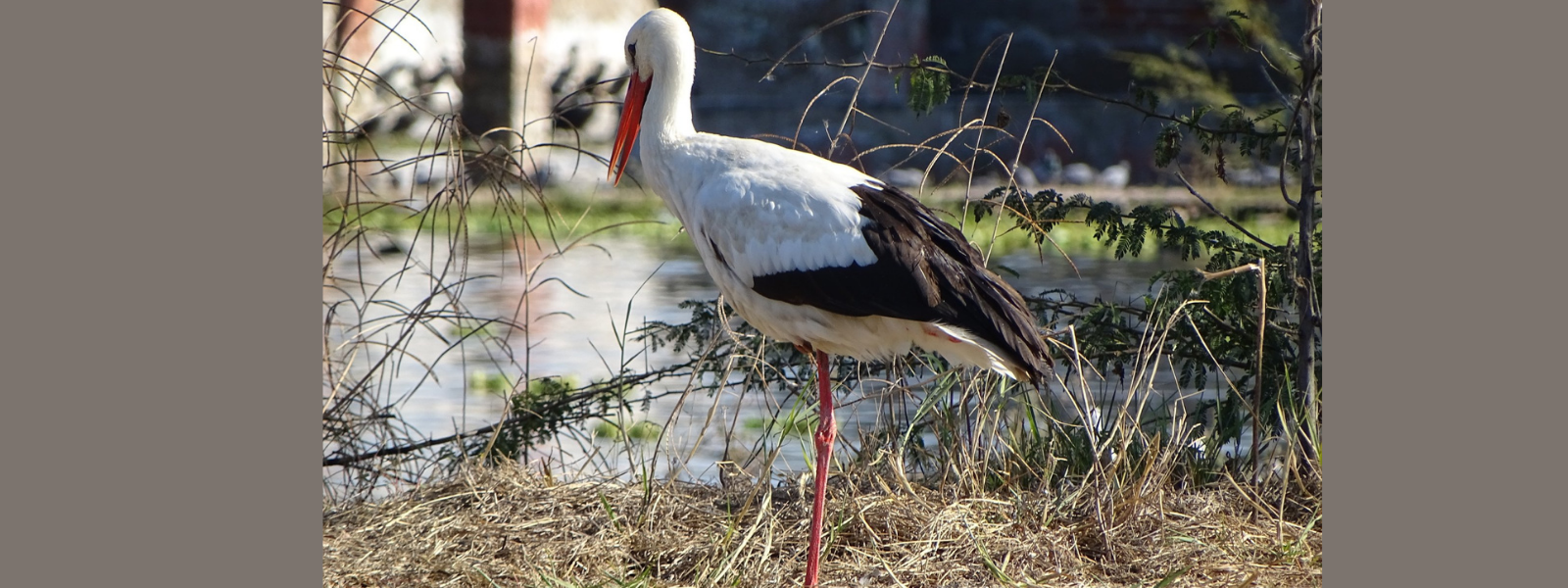
The White Stork, a migrant bird wintering sometimes in South Asia. (Photo by Praveen Mathur, source: internet used by birdlifenepal.org)
It walks slowly and steadily on the ground. Like all storks, it flies with its neck outstretched.
Conservation details here.






